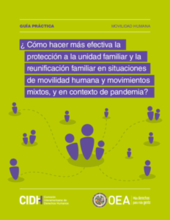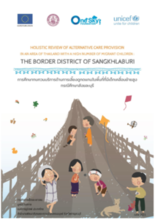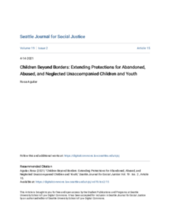Displaying 131 - 140 of 835
la Comisión Interamericana presenta la guía ¿Cómo hacer más
efectiva la protección a la unidad familiar y reunificar a la familia en los procedimientos migratorios y de protección en contexto de pandemia? en la que
se analizan los estándares interamericanos aplicables a la luz de las obligaciones
internacionales de los Estados y propone recomendaciones para garantizar la unidad
familiar y la reunificación familiar así como prevenir los riesgos de separación y minimizar los impactos en los casos de separación familiar. Asimismo, la implementación
de las garantías de la reunificación familiar requiere muchas veces de una estrategia idónea de acceso a mecanismos de regularización documental, así como de condiciones seguras de viaje y movilidad a través de las fronteras nacionales. Esto es especialmente benéfico para familias que se han visto separadas de manera forzada o por
razones asociadas a la movilidad humana.
This review was conducted in different forms of institutional care: private residential care, (charity) boarding schools, and temple as well as (informal) kinship care. The findings and recommendations were presented to the Thailand Provincial Social Development and Human Security Office and the Department of Children and Youth to further develop an alternative care road map and plan of action.
The purpose of this study was to explore the level of caregiver burden and parenting stress and their relationship among left-behind elderly individuals.
This article offers an account of the authors’ experiences as foster carers for an unaccompanied asylum seeker (and through him, supporting other asylum-seeking boys).
This study examined the mental health of Middle Eastern male unaccompanied refugee adolescents in Germany in relation to the mental health of accompanied refugee peers, first- and second-generation immigrant and native peers.
This article argues that the U.S. Congress should make changes to extend protections under Special Immigrant Juvenile Status (SIJS). These implementations would give effect to the legislative intent behind SIJS, which is to protect the particularly vulnerable group of unaccompanied children and youth.
Through an analysis of the impact of the pandemic on the Italian and Greek reception systems and social interventions with unaccompanied minors (UAMs), the authors of this study utilised a multiple embedded case study approach within a comparative analysis, to identify key changes in the main services which should be guaranteed to minors—namely, hosting/housing, guardianship, foster care, family/relatives reunification, school integration, language, job training for care leaving, and preparation for leaving care after 18 years.
This study used community‐participatory qualitative methods to deeply explore the lived experiences and emotional repercussions of family separation and reunification.
Analyzing unique data from the 2017 Myanmar Grandparents Caring for Grandchildren Survey, this study examines the extent to which the middle generation's cross-border and internal migration are associated with caregiving intensity, perception towards grandchild care, and psychological well-being among grandparents.
This issue brief surveys the existing literature based on the limited available data to highlight areas of urgent concern for children on the move as they navigate life during the pandemic, examined through the lens of gender.







